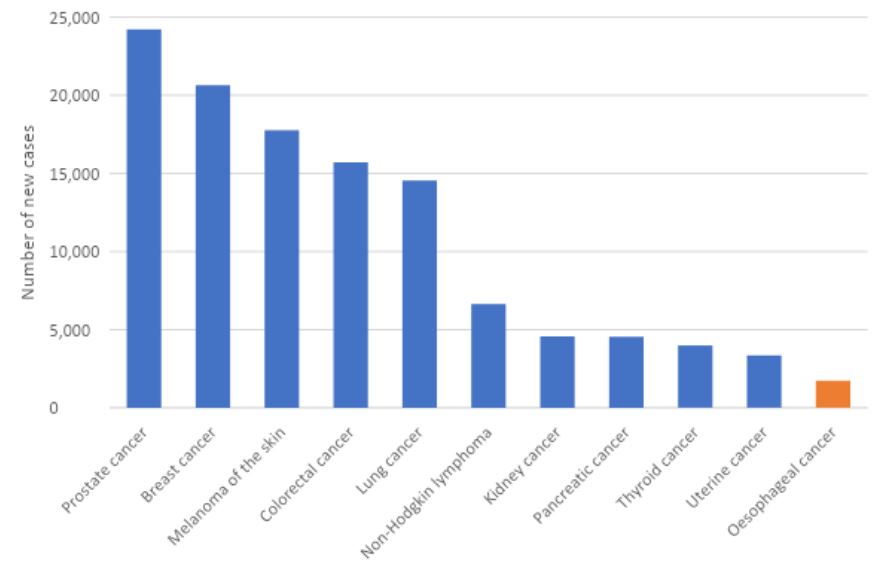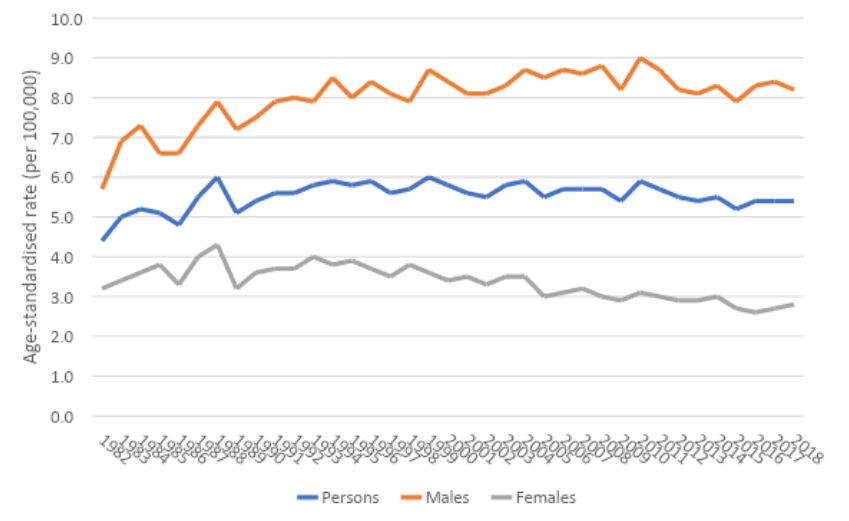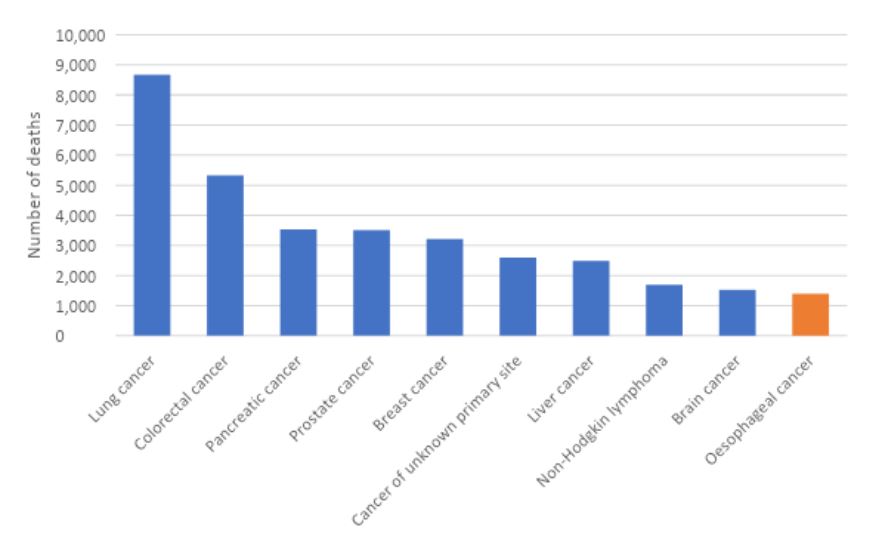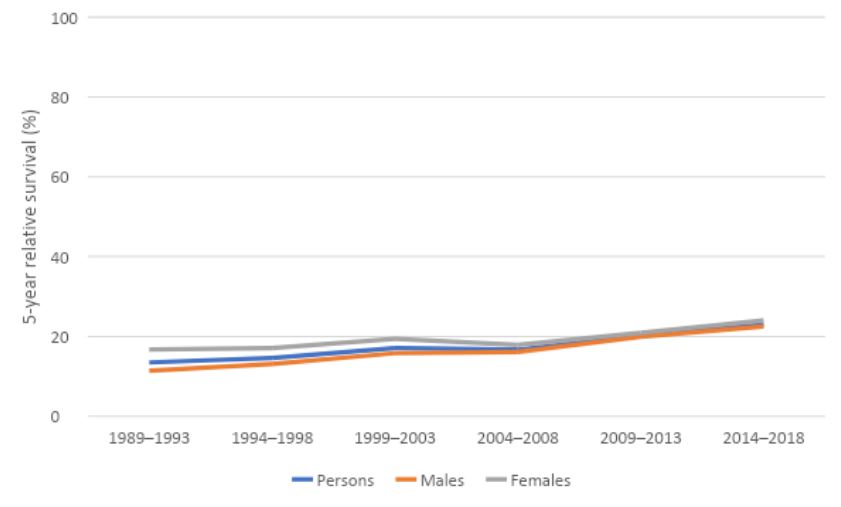The following material has been sourced from the Australian Institute of Health and Welfare
Oesophageal cancer incorporates ICD-10 cancer code C15.
Estimated number of new cases of oesophageal cancer diagnosed in 2022
1,725 =  1,255 males +
1,255 males +  470 females
470 females
Estimated % of all new cancer cases diagnosed in 2022
1.1%
Estimated number of deaths from oesophageal cancer in 2022
1,394 =  1,052 males +
1,052 males +  342 females
342 females
Estimated % of all deaths from cancer in 2022
2.8%
Chance of surviving at least 5 years (2014–2018)
23%
People living with oesophageal cancer at the end of 2017 (diagnosed in the 5 year period 2013 to 2017)
2,785
New cases
In 2018, there were 1,610 new cases of oesophageal cancer diagnosed in Australia (1,151 males and 459 females). In 2022, it is estimated that 1,725 new cases of oesophageal cancer will be diagnosed in Australia (1,255 males and 470 females). In 2022, it is estimated that a person has a 1 in 170 (or 0.59%) risk of being diagnosed with oesophageal cancer by the age of 85 (1 in 115 or 0.87% for males and 1 in 331 or 0.30% for females).

Figure 1. Estimated cancer incidence in Australia, 2022
Notes
- Data sourced from AIHW Cancer Data in Australia 2022 web report and supplementary data tables
- More information about incidence rates for the most common cancers diagnosed can be found on the NCCI website in the ‘Cancer incidence’ section (https://ncci.canceraustralia.gov.au/diagnosis/cancer-incidence/cancer-incidence)
In 2018, the age-standardised incidence rate was 5.4 cases per 100,000 persons (8.2 for males and 2.8 for females). In 2022, it is estimated that the age-standardised incidence rate will be 5.1 cases per 100,000 persons (7.9 for males and 2.6 for females). The incidence rate for oesophageal cancer is expected to increase with age.

Figure 2. Age-standardised incidence rates for oesophageal cancer, 1982 to 2018, by sex
Notes
- Data sourced from AIHW Cancer Data in Australia 2022 web report and supplementary data tables
- More information about incidence rates for oesophageal cancer over time, by age, sex, Indigenous status, remoteness, and socioeconomic status (SES) can be found on the NCCI website in the ‘Cancer incidence’ section (https://ncci.canceraustralia.gov.au/diagnosis/cancer-incidence/cancer-incidence)
The number of new cases of oesophageal cancer diagnosed increased from 537 (317 males and 220 females) in 1982 to 1,610 in 2018. Over the same period, the age-standardised incidence rate remained similar from 4.4 cases per 100,000 persons (5.7 for males and 3.2 for females) in 1982 to 5.4 cases per 100,000 in 2018.
Deaths
In 2020, oesophageal cancer was the eleventh most common cause of cancer death in Australia. It is estimated that it will become the tenth most common cause of death from cancer in 2022.
In 2020, there were 1,341 deaths from oesophageal cancer in Australia (1,024 males and 317 females). In 2022, it is estimated that there will be 1,394 deaths (1,052 males and 342 females). In 2022, it is estimated that a person has a 1 in 217 (or 0.46%) risk of dying from oesophageal cancer by the age of 85 (1 in 140 or 0.72% for males and 1 in 488 or 0.21% for females).

Figure 3. Estimated cancer mortality in Australia, 2022
Notes
- Data sourced from AIHW Cancer Data in Australia 2022 web report and supplementary data tables
- More information about mortality rates for the most common causes of cancer death can be found on the NCCI website in the ‘Cancer mortality’ section (https://ncci.canceraustralia.gov.au/outcomes/cancer-mortality/cancer-mortality)
In 2020, the age-standardised mortality rate was 4.2 deaths per 100,000 persons (6.9 for males and 1.8 for females). In 2022, it is estimated that the age-standardised mortality rate will be 4.1 deaths per 100,000 persons (6.7 for males and 1.8 for females). The mortality rate for oesophageal cancer is expected to increase with age.

Figure 4. Age-standardised mortality rates for oesophageal cancer, 1982 to 2020, by sex
Notes
- Data sourced from AIHW Cancer Data in Australia 2022 web report and supplementary data tables
- More information about mortality rates for oesophageal cancer over time, by age, sex, Indigenous status, remoteness, and socioeconomic status (SES) can be found on the NCCI website in the ‘Cancer mortality’ section (https://ncci.canceraustralia.gov.au/outcomes/cancer-mortality/cancer-mortality)
The number of deaths from oesophageal cancer increased from 527 (338 males and 189 females) in 1982 to 1,341 in 2020. Over the same period, the age-standardised mortality rate remained similar from 4.4 deaths per 100,000 persons (6.4 for males and 2.9 for females) in 1982 to 4.2 deaths per 100,000 in 2020.
Survival
In 2014–2018, individuals diagnosed with oesophageal cancer had a 23% chance (23% for males and 24% for females) of surviving for five years compared to their counterparts in the general Australian population. Between 1989–1993 and 2014–2018, five-year relative survival for oesophageal cancer improved from 14% to 23%.

Figure 5. 5-year relative survival for oesophageal cancer, 1989–1993 to 2014–2018, by sex
Notes
- Data sourced from AIHW Cancer Data in Australia 2022 web report and supplementary data tables
- More information about 5-year relative survival rates for oesophageal cancer over time, by age, sex, Indigenous status, remoteness, and socioeconomic status (SES) can be found on the NCCI website in the ‘Relative survival rate’ section (https://ncci.canceraustralia.gov.au/outcomes/relative-survival-rate/5-year-relative-survival-diagnosis)
Prevalence
At the end of 2017, there were 1,120 people living who had been diagnosed with oesophageal cancer that year, 2,785 people living who had been diagnosed with oesophageal cancer in the previous 5 years (from 2013 to 2017) and 4,906 people living who had been diagnosed with oesophageal cancer in the previous 36 years (from 1982 to 2017).
For more information, see Oesophageal cancer on the NCCI website
The National Cancer Control Indicators (NCCI) are a set of indicators across the continuum of cancer care, from Prevention and Screening through to Diagnosis, Treatment, Psychosocial care, Research and Outcomes. The NCCI website allows users to see visual representations of data on each indicator through interactive charts.




